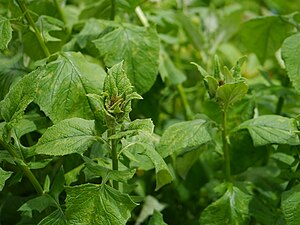Note: This is a project under development. The articles on this wiki are just being initiated and broadly incomplete. You can Help creating new pages.
Difference between revisions of "Saussurea lappa - Kusta"
| Line 1: | Line 1: | ||
| − | [[File:Saussurea costus (7838360258).jpg|thumb|right|]] | + | [[File:Saussurea costus (7838360258).jpg|thumb|right|''Kost'']] |
'''Saussurea costus''' is a species of thistle in the genus Saussurea native to South Asia. Essential oils extracted from the root is used in traditional medicine and in perfumes since ancient times. | '''Saussurea costus''' is a species of thistle in the genus Saussurea native to South Asia. Essential oils extracted from the root is used in traditional medicine and in perfumes since ancient times. | ||
Revision as of 16:22, 6 June 2018
Saussurea costus is a species of thistle in the genus Saussurea native to South Asia. Essential oils extracted from the root is used in traditional medicine and in perfumes since ancient times.
Contents
- 1 Uses
- 2 Parts Used
- 3 Chemical Composition
- 4 Common names
- 5 Properties
- 6 Habit
- 7 Identification
- 8 List of Ayurvedic medicine in which the herb is used
- 9 Where to get the saplings
- 10 Mode of Propagation
- 11 How to plant/cultivate
- 12 Commonly seen growing in areas
- 13 Photo Gallery
- 14 References
- 15 External Links
Uses
cough, asthma, fever, ulcers, hair problems, Indigestion, gas problems, Intestinal diseases, cholera.
Parts Used
Chemical Composition
Phytochemical analysis of S. lappa roots showed the presence of monoterpenes, sesquiterpenoids, flavonoids, lignans, triterpenes, steroids, glycosides etc. S. lappa roots are rich source of sesquiterpenoids specially sesquiterpene lactones[1]
Common names
| Language | Common name |
|---|---|
| Kannada | kankushta, koshta |
| Hindi | kut, kur |
| Malayalam | sepuddy |
| Tamil | Potchuk |
| Telugu | changala |
| Marathi | NA |
| Gujarathi | NA |
| Punjabi | NA |
| Kashmiri | NA |
| Sanskrit | kustha |
| English | Kust |
Properties
Reference: Dravya - Substance, Rasa - Taste, Guna - Qualities, Veerya - Potency, Vipaka - Post-digesion effect, Karma - Pharmacological activity, Prabhava - Therepeutics.
Dravya
Rasa
Tikta (Bitter).
Guna
Laghu (Light), Ruksha (Dry), Tikshna (Sharp)
Veerya
Ushna (Hot)
Vipaka
Katu (Pungent)
Karma
Kapha, Vata
Prabhava
Habit
Identification
Leaf
| Kind | Shape | Feature |
|---|---|---|
| Simple | The leaves are divided into 3-6 toothed leaflets, with smaller leaflets in between |
Flower
| Type | Size | Color and composition | Stamen | More information |
|---|---|---|---|---|
| Unisexual | 2-4cm long | Yellow | 5-20 | Flowers Season is June - August |
Fruit
| Type | Size | Mass | Appearance | Seeds | More information |
|---|---|---|---|---|---|
| 7–10 mm (0.28–0.4 in.) long pome | clearly grooved lengthwise, Lowest hooked hairs aligned towards crown | With hooked hairs | {{{6}}} |
Other features
List of Ayurvedic medicine in which the herb is used
- Vishatinduka Taila as root juice extract
Where to get the saplings
Mode of Propagation
How to plant/cultivate
Succeeds in most soils in a sunny well-drained position[3]
Commonly seen growing in areas
Tall grasslands, meadows, Borders of forests and fields.
Photo Gallery
References
External Links
- Ayurvedic Herbs known to be helpful to treat cough
- Ayurvedic Herbs known to be helpful to treat asthma
- Ayurvedic Herbs known to be helpful to treat fever
- Ayurvedic Herbs known to be helpful to treat ulcers
- Ayurvedic Herbs known to be helpful to treat hair problems
- Ayurvedic Herbs known to be helpful to treat Indigestion
- Ayurvedic Herbs known to be helpful to treat gas problems
- Ayurvedic Herbs known to be helpful to treat Intestinal diseases
- Ayurvedic Herbs known to be helpful to treat cholera
- Herbs with Roots used in medicine
- Herbs with Stem used in medicine
- Herbs with common name in Kannada
- Herbs with common name in Hindi
- Herbs with common name in Malayalam
- Herbs with common name in Tamil
- Herbs with common name in Telugu
- Herbs with common name in Sanskrit
- Herbs with common name in English
- Habit - Herb
- Index of Plants which can be propagated by Seeds
- Index of Plants which can be propagated by Division in spring
- Herbs that are commonly seen in the region of Tall grasslands
- Herbs that are commonly seen in the region of meadows
- Herbs that are commonly seen in the region of Borders of forests and fields
- Herbs



